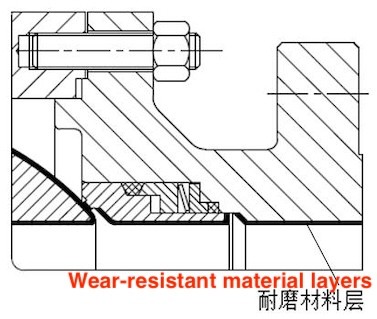At present, the main production processes of polysilicon include the modified Siemens process, silane process and vulcanized bed process, among which the improved Siemens process is the main process used. The improved Siemens process is used to explain the working environment of polysilicon device pipelines. The main process flow of the improved Siemens method is that high-purity quartz (SiO2) plus C is reduced at high temperatures to obtain 98% industrial silicon. Industrial silicon is used as raw material plus hydrochloric acid (HCl) reacts on the sulfide bed to generate trichlorosilane (SiHCl3) and hydrogen (H2), and then hydrogenate trichlorosilane (SiHCl3) is used to reduce silicon (Si). From this analysis, it can be concluded that in the reactors and pipelines in the polysilicon production process, the valves are exposed to harsh working conditions such as particles, dust, high temperature, hydrogen exposure, corrosion, and flammable and explosive environment. As an essential control component for pipelines, there are many valves. Ball valves are widely used because of their inherent advantages of full bore and low flow resistance. The ball valves at the core of polycrystalline silicon process equipment and transportation pipelines are mostly high-temperature metal metal-seated and wear-resistant trunnion ball valves.
In summary, the working conditions of polysilicon equipment and pipelines are special and the media are complex, including oxygen, hydrogen, chloride, high-hardness trichlorosilane mixture dust particles and highly corrosive hydrochloric acid. Reasonable selection of the main body material and seal material of ball valves in polysilicon pipelines, as well as heat treatment and surface treatment of these materials, are important foundations for ensuring the reliable and safe operation of ball valves in polysilicon pipelines.
Material selection for polycrystalline silicon pipeline trunnion ball valves
Main materials
The main material of high-temperature metal seated and wear-resistant trunnion ball valves should be resistant to wear, high temperature, oxidation and hydrogen embrittlement based on the working conditions of polysilicon pipelines. According to the commonly used diameter and pressure range, carbon steel such as WCB or A105, austenitic stainless steel such as ASTM A182 F304, F304L, F316 and F316L or ASTM A351 CF8, CF3, CF8M and CF3M are often used. For trunnion ball valves used in extreme wear and high-temperature pipelines or at the inlet and outlet of reactors, taking into account the service life and cost of use, carbon steel WCB or A105 inner cavity can also be integrally cladded with high-temperature and wear-resistant materials with a thickness greater than and equal to 3mm to improve the performance of the shell (Figure 1).

Figure 1 The inner cavity of surfacing welding
With the continuous development of surface treatment of materials, more surface treatments can be used for the valve body cavity, flow channel and ball hole, such as supersonic spraying (HVOF), flame powder remelting, laser cladding and other processes. Spraying and cladding wear-resistant alloy materials can make the bonding force better, further improve the erosion resistance and anti-corrosion performance, and make the selection of main materials wider and reduce production costs.
Surface treatment of balls and sealing surface materials of valve seats
The ball and valve seat are important internal parts of high-temperature metal seated and wear-resistant trunnion ball valves for polysilicon pipelines. The base material should have better performance than the valve body, valve bonnet and other shell materials. The ball and valve seat are generally made from carbon steel or austenitic steel that is integrally forged. The surface treatment of the ball and valve seat surface is mainly to solve wear and scouring of the sealing surface by silicon powder, and also consider the corrosion of the sealing surface by corrosive media like hydrogen chloride. Therefore, the surface of the sphere is generally treated with supersonic spraying of tungsten carbide (WC) and chromium carbide (CrC), as well as flame powder remelting and laser cladding of wear-resistant alloys. The coating thickness is generally 0.3 to 0.6 mm, and the hardness is greater than 75HRC, making it exceed the hardness of silicon powder particles. The bonding strength between the wear-resistant alloy and the sphere is greater than 100 MPa, which improves the scouring resistance and anti-corrosion performance of the sphere surface, thereby meeting the performance of the sphere in polysilicon. The valve seat sealing surface is also processed by surfacing or spraying alloy materials to increase the surface's hardness. However, attention should be paid to maintaining a certain hardness difference between the valve seat sealing surface and the ball surface to avoid scratching the sealing pair and affecting the service life of the metal seated and wear-resistant trunnion ball valve.
Other matters needing attention
The working conditions and media of polysilicon devices and pipelines are complex. If used in flammable and explosive gas pipelines such as oxygen and hydrogen pipes, ball valve parts should strictly comply with the JB/T 10520-2005 standard. The material should be deoiled and degreased. If the ball valve is made from carbon steel other than copper alloy and austenitic stainless steel, anti-rust packaging after deoiling and degreasing should be considered to prevent the ball valve from rusting during transportation and storage.